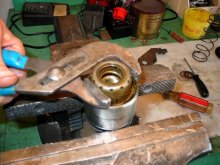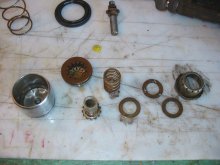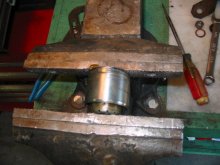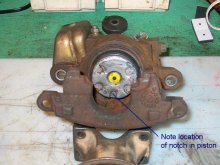Now we come to the interesting part- disassembling the piston. The caliper used for these photos was in pretty good shape, but the piston assemblies in the calipers on my Bronco were gummed up and corroded. Most people never bleed their brakes regularly to renew the fluid. Brake fluid absorbs water and anything else it can from the environment, and eventually it corrodes metal parts. In the case of these calipers, it eventually locks up the adjuster mechanism.

To disassemble the piston, I clamp the end of it, the part that sticks out of the dust seal, in a vise. Then I use a pair of water pump pliers to carefully twist the stamped steel retainer out of the piston.

A bit blurry, but this is what's visible after the retainer is removed. All of the parts can come out, including the plug at the bottom with the female spline. If it's reluctant, it can be pushed out by inserting a small rod or punch through the hole in the face of the piston.

And finally, the piston and its contents laid out on the bench. It's important that the three balls captured in the round plate be able to rotate freely. If they can't the clutch mechanism won't work- it functions by jamming when a load is applied (when the e-brake is engaged) but allows everything to rotate freely relative to the piston when the force is removed. So clean those bits well before reassembly.

After cleaning and reinstalling the parts in the piston, I pushed the retainer in by hand. Then I squeezed the thing in my vise until the retainer was sticking out of the piston by 3/8".
Now it's time to install the piston back into the caliper. Spin the actuating shaft into the piston and seat the spring against the retainer. With the caliper clamped in a vise, push everything into the bore until the threaded part of the actuator shaft emerges from the hole. That spring tries hard to shove the piston out of its bore, but once the piston is pushed past the o-ring seal, it tends to stay put. Install the nylon washer and rubber seal over the actuator shaft, followed by the e-brake arm and the retaining nut. The exact clocking of the e-brake arm doesn't matter at this point. The piston dust seal comes next. It's easier to do if the piston is sticking out of the bore about 3/4" or so. If you pushed it in too far, now is when you get to see how the clutch mechanism in the piston works. Cycle the e-brake arm back and forth and it should gradually "pump" the piston out of the bore. Install the seal using a blunt instrument (I used the handle end of an old toothbrush) and slide the lip down until it seats in the groove on the piston.

The next step is to bottom the piston in the bore and orient it correctly. See the notch in the face of the piston? It engages a square bump on the back of the brake pad. That keeps the piston from rotating when the e-brake is applied and released. It needs to be oriented a particular way, as shown in the photo.
The tool in the background is for rotating the piston. It's designed to fit on a 3/8" drive ratchet. It has a square bump on the face to engage the piston notch, and a a raised boss in the middle that goes in a depression in the middle of the piston, to hold things in alignment while turning. Rotating it also retracts the piston, as it drives the piston up the actuating shaft. When doing this sometimes the piston bottoms before the notch is oriented correctly. Cycle the e-brake arm a couple of times to drive the piston back out a bit, then repeat.
Here's a photo showing the piston retraction tool in use.
Well, sometimes that tool just won't work as advertised. If the caliper has been around the block a few times (most have) the notch in the piston may be rounded off, in which case the tool slips no matter how hard you push down on it while turning. In that case, I use my secret weapon.
From the looks of the piston, I wasn't the first to use this procedure.
Once the piston is retracted and oriented correctly, pop the dust seal (yellow plug visible in some of the pictures) into the hole in the face of the piston, assuming it was still there when you got the calipers. If you bought a rebuild kit, you got a new one. The brake pads can then be fit to the caliper. One thing not shown here is a wire spring clip that fits in the groove at the top edge of the piston. It's an anti-rattle device for the inner brake pad. The spring was there when I got the caliper, but went sailing into the thorn bushes when I bumped it while taking the caliper outside to brush off some of the dirt. It's still there. My thorn bushes don't like me and it will take more than the loss of a clip to get me to wade into them again.
That's it! The caliper is now ready for installation. Once mounted on the vehicle, cycle the e-brake arm a few times before connecting the cables in order to advance the piston out and get the pads in contact with the rotor. If you bought a kit, follow the directions supplied with the kit to complete the installation. In general, disc style emergency brakes don't work as well as drums, due to the latter's self-energizing nature. But mine hold well enough with 35" tires to keep my Bronco from rolling onto the street from my sloping driveway, and of course now my rear brakes stay in adjustment. Most importantly (why we install rear discs in the first place) my Bronco stops straight and true, rain or shine, in the dust, or after water crossings.
Tech article by Lars Pedersen (Lars)
|



